Favorite Board Games for 4-year-olds.
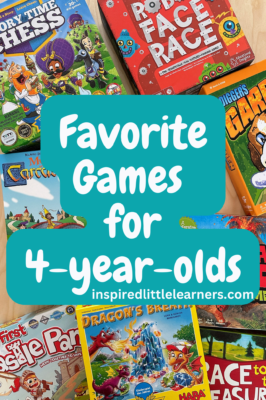
Age 4 is a really fun age to play board games! If you have been playing games with your child since they were 2 or 3-years-old, by age 4, they are familiar with basic game play (taking turns, how to roll a dice, how to move on a game board, etc) and at age 4, you can start introducing games that are a little more complex. Most of the games on the list below use some strategy in the game play. When first introducing games that use strategy, I often help my kids on their turn, by talking through different moves they can make and then allowing them to decide. Through this gentle introduction, they develop more strategic thinking skills and start making their own strategic moves during board games! As a parent, it’s really fun to watch your child use critical thinking skills and make strategic moves while playing games.
This is my third post in a series of posts that will list favorite games by age!
Use these posts as a loose guideline- just because a board game shows up in a list for one age, doesn’t mean that it can’t be enjoyed by kids of other ages as well!! All of the games on the list below are ones that my kids still love at ages 5 & 6.
Make sure you also check out my posts of Favorite Board Games for 2-year-olds and Favorite Board Games for 3-year-olds.
This post may contain affiliate links. As an Amazon Associate and participant in other affiliate programs, I earn a small commission on qualifying purchases (at no additional cost to you). Thank you for your support! Read our affiliate disclaimer here.
Dinosaur Escape by Peaceable Kingdom
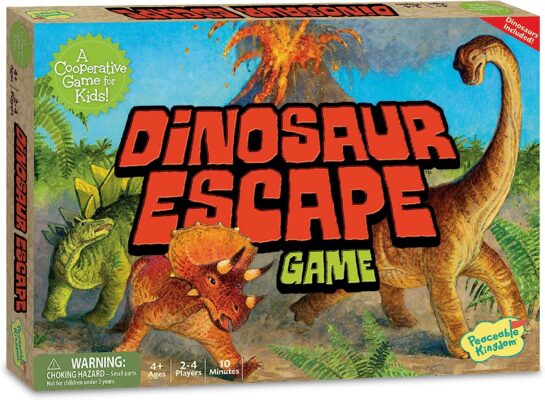
The first game on my list of recommendations is the cooperative game Dinosaur Escape by Peaceable Kingdom. We are big fans of cooperative games because they emphasize teamwork and working together and keep the focus on having fun together rather than being competitive. Dinosaur Escape involves memory, counting, and strategy skills, and a bit of luck! Dinosaur Escape is a great introduction to strategic games because all players work together, so you can discuss what move should be made on each turn. During the game, players take turns rolling a die to move three dinosaur figurines around the board, turning over fern tokens as they move. If you reveal a dinosaur on a token and that figurine is in the same habitat as the token, you have helped the dinosaur move the dinosaur to Dinosaur Island! Fern tokens also contain other objects (rocks, bones, etc); after revealing an object on a fern token, you flip it back over before the next person’s turn. Throughout the game, players must remember which fern tokens have already been turned over as they search to reveal the dinosaurs. If a player rolls a volcano on the die, one piece is added to a cardboard volcano. The object of the game is to work together to help all three dinosaurs escape to dinosaur island before the volcano has been built!
My First Castle Panic by Fireside Games
The next game on my list of recommendation is another cooperative game! My First Castle Panic by Fireside Games is the “junior” version of the game Castle Panic, which I have never played, but after playing My First Castle Panic, I look forward to trying the original version once my kids are older. In this game, players work together to catch monsters before they reach the castle. This game uses strategic thinking and planning ahead as you decide what card to play on each turn, and players use color and shape matching skills as they play.
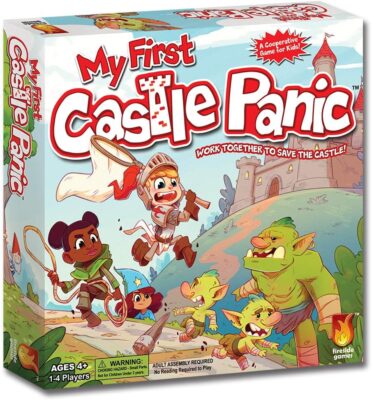
My First Carcassonne by Z-Man Games
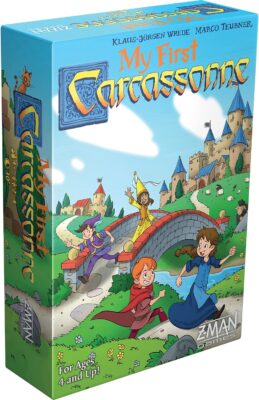
My First Carcassonne is a simplified version of the game Carcassonne by Z-Man Games. This game is very straightforward and easy-to-learn. On your turn, you reveal a tile card. On each side of a tile card, there is a road and on the roads the kids of Carcassonne are illustrated. The kids are dressed in one of four colors, the colors are the same as the pawns used in the game. After revealing a tile, the player adds it to the other tiles on the table, so that the roads connect. On some tiles, the road will be closed off by a house, pond, wall, etc. When a road is closed on both ends, players place their pawns on the corresponding kids (kids wearing the same color) that are on the road. The first player to place all 8 of their pawns wins! In order to maximize how quickly you can place your pawns onto the road, this game involves strategic thinking when placing the tiles, but the game is fun to play even if players don’t use strategic planning! I love that this game is easy-to-play and it is made with durable materials- the pawns are wooden tokens and the tiles are made from thick cardboard. This is definitely a game that can be enjoyed for many years!
Story Time Chess
I didn’t learn to play chess until I was in high school (and decided to join the Chess Club) and after high school, I rarely played. Honestly, I probably haven’t played chess in over 20 years! – until I found Story Time Chess and decided to teach my own kids how to play! This game is AMAZING! It teaches kids how to play chess through fun and engaging (and silly) stories! The stories help to keep kids’ attention and reinforce the rules of the game as they learn how to play! With this game, you read one chapter in the story book and then play a few mini games (included in the book) to learn how one of the game pieces move on the chess board. Once you have confidently learned how that chess piece moves, you move onto the next chapter that introduces another chess piece. You can move through learning each chess pieces slowly (with repetition) to ensure that the child remembers how that chess piece moves. It has been truly amazing how much my kids (even my 2.5-year-old) remembers from the book and the mini games! We were at a restaurant that had a chess board set out and my kids could name each chess piece and how the pieces move!
There are also two levels of Strategy Expansion Packs available. Find them here.
Also, check out Storytime Backgammon

Robot Face Race by Educational Insights
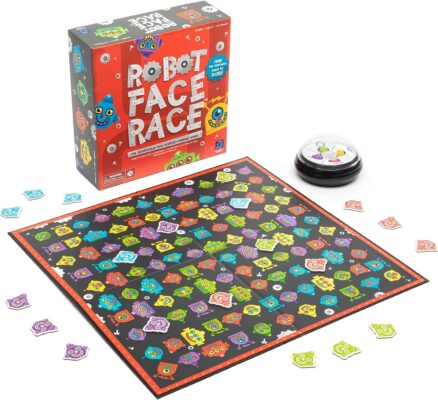
Robot Face Race by Educational Insights is a seemingly simple game: all players try to be the first to identify a robot with features that are a certain color. But, there are over 120 robot faces on the gameboard, which makes the game challenging and keeps it fresh each time you play (no memorizing where each face is)! To play, one player shakes the Randomizer, which will decide what color the robot’s eyes, nose, mouth and face are. Then all players search on the gameboard for the robot with that combination of features. The first player to place their token on the correct robot gets to keep that token and the first player to collect 5 tokens wins! Let’s talk about the Randomizer for a minute- I love the unique design of this game component! A player shakes the Randomizer and 5 colored balls fall into holes, but only 4 holes are visible each time it’s shaken (the fifth ball falls into a hole not visible once the Randomizer is set on the table). This leads to more color combinations for the robots’ features. In addition to being a simple (but challenging) game for 4-year-olds, it also develops visual discrimination (as players scan the board looking for the correct robot), which is an important pre-reading skill and one reason I love this game for preschoolers!
Dragon’s Breath by HABA
My kids have a recent obsession with dragons, so as soon as I saw this game, I knew it would be a hit! Plus we love the games by HABA and this one does not disappoint! Dragon’s Breath by HABA is a game with a unique gameplay and it only takes about 15-20 minutes to play (which is important when playing games with preschoolers!) To set up the game, you create a column of ice (using plastic rings) and you place sparkling stones on the inside of the ice column. The game is played in rounds and each player will get a chance to start a round. The player starting the round places a wooden Dragon Dad figurine in front of them. During a round, each player selects one color of sparkling stone (there are 5 colors total). The player with the Dragon Dad lifts the top ice ring, causing some of the sparkling stones to fall. All players collect their color of sparkling stone. After all of the rounds have been played, the players count how many sparkling stones they collected and the player with the most sparkling stones wins! This game involves color recognition skills, fine motor skills (as you remove the rings and collect the tiny stones) and is great for counting practice. Once all of the rounds are complete players will usually have collected at least 20 stones, so it is a great game for preschoolers to practice counting larger numbers using 1:1 correspondence. For additional practice, we sometimes count our sparkling stones by 2s. Although strategy is not required for game play, players can use strategy! The player that removes the ice ring may choose to carefully remove the ring, so that few sparkling stones fall, or they may remove the ring in a way that causes many stones to fall – how a player chooses to remove the ring, will depend on the color of the sparkling stones near the top and the color of sparkling stones they are collecting on that round!

Digger’s Garden Match by SimplyFun
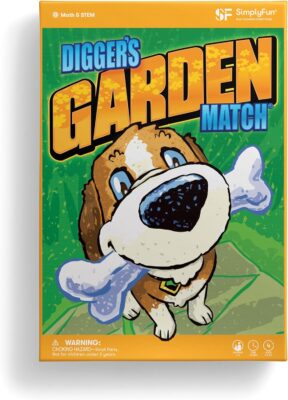
Digger’s Garden Match by SimplyFun is a game we recently added to our collection and it’s become an immediate favorite! It is perfect for kids ages 4 and up, who are practicing colors, shapes, counting and matching skills! Players take turns laying tiles to match color or shape. After matching a tile, players count how many shapes are on the tiles they matched and move their dog bone along the board to score points. The first player to reach 50 points wins! In addition to matching colors and shapes, this game is great for counting practice using 1:1 correspondence. It’s also a great game for practicing early strategizing skills, as players decide which tile to play in order to maximize how many points they score on a turn!
Race to Treasure by Peaceable Kingdom
The last game on my list of favorite board games for 4-year-olds, is another cooperative game. In Race to Treasure by Peaceable Kingdom, all players work together to collect 3 keys on the board game by laying path tiles on the game board. Players try to create a path to collect the treasure before the ogre! Cooperative games are great early strategizing games, because players can talk about the possible moves as they work together to win the game! In this game, you also use future planning, as you need to think a couple moves ahead in order to place tiles that will allow you to reach the keys.
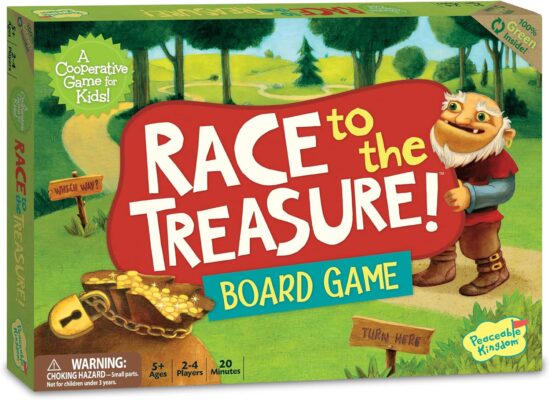
If you are interested in more favorite games by age group, be sure to check out these posts:
Favorite Games for 2-year-olds
Favorite Games for 3-year-olds
If you are looking for more game recommendations for preschool-age kids, be sure to check out these posts:
Five Preschool Games for Learning Colors
Seven Great Games for Preschoolers
